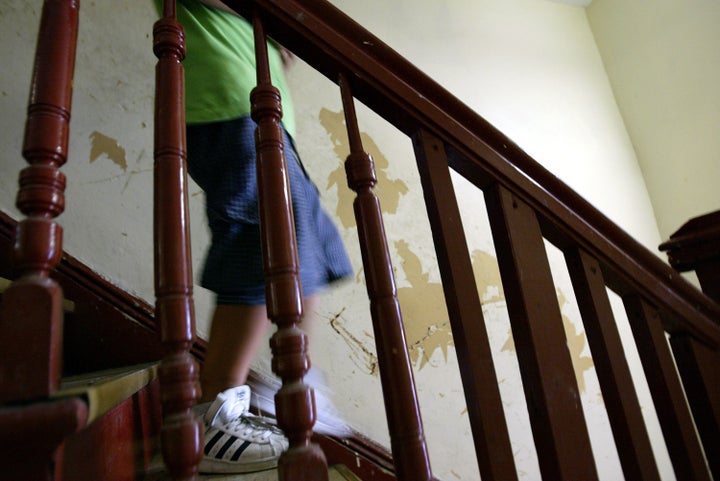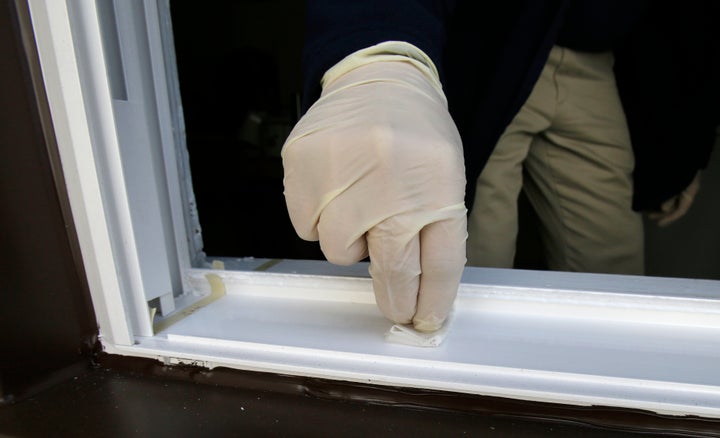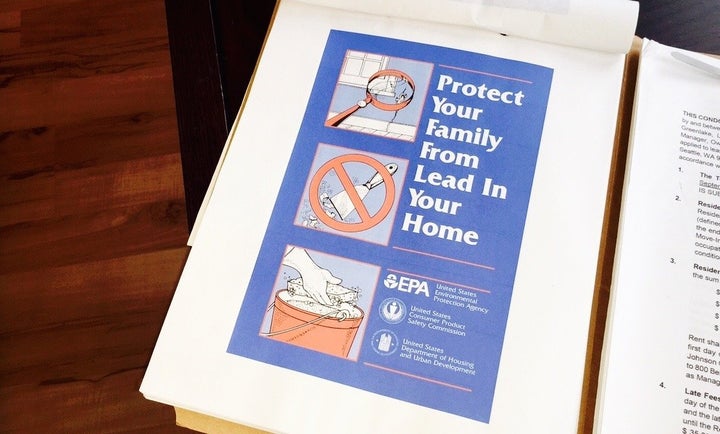
When Jon Fishman's family moved into their 200-year-old Maine farmhouse years ago, they didn't think to be concerned about lead paint hazards. That all changed this February, a few minutes after a pediatrician pricked their toddler son's toe. The rapid blood test revealed the presence of lead.
Tiny, largely invisible particles of the poison, they would later confirm, had taken residence in their home -- making them one of the at least 4 million households with children that are exposed to deteriorated lead paint and elevated levels of lead dust, according to the U.S. Centers for Disease Control and Prevention. Now Fishman, the drummer for the band Phish, wants to share what he's learned so that other parents have their young children screened for lead. He also wants to ensure people avoid renting, buying, selling or remodeling a home while blind to the threat of the neurotoxic heavy metal.
"I'm just trying to parlay the little celebrity I have to raise awareness," he said. Fishman recently donated to the completion of "MisLEAD," a forthcoming film on the lead issue, and will be hosting screenings in Vermont this October.
Homes built in the early to mid-20th century, during the heyday of lead-based paint, are most worrisome. Yet risks may reside in and around any building constructed or painted before 1978, when lead was finally banned from residential paint sold in the U.S.
"Lead is all over the damn place — aging and chipping," said Fishman, who also discovered lead hazards in a lakeside cottage and a general store his family owns. "It's an epidemic. And it's causing serious health problems in lots of kids around the country."
Of course, the majority of children who suffer from lead poisoning aren't celebrity kids with multiple residences. Risks are generally highest in low-income communities, where lead paint can often be seen peeling from poorly-maintained properties. But the poison can still find its way onto the hands and into the mouth of any child.

"Lead's presence in the environment has nothing to do with being rich or poor. More rich people are buying older places, and then going in and stirring up the lead," added Fishman. "That's exactly what I did."
Thanks in part to the ban on lead paint, the rise of lead-safe regulations and more widespread awareness, fewer children today are exposed to very high levels of lead -- concentrations that in previous generations all-too-commonly produced obvious, devastating effects such as seizures or death. Scientific findings over recent years, however, have taken some of the wind out of the public health community's sails: even very low levels of exposure to lead can also cause long-term, albeit more subtle, harm.
The CDC responded to this mounting evidence in 2012 by reducing the level at which they consider a child to be lead poisoned from 10 to 5 micrograms per deciliter of blood. Still, nearly all states continue to use a threshold of 10 micrograms or higher before they take an action such as forcing a landlord to remediate a property. Maine passed a law this summer to become the first state in the country to set the CDC's blood lead level of 5 micrograms per deciliter as its official threshold of intervention.
Leading health experts, meanwhile, warn that there is no "safe" level of lead in the blood. A developing child's exposure to just a speck of lead dust, research suggests, may leave them a little slower to learn, a little shorter of attention, a little less successful on tests and at work, and a little more likely to engage in criminal activity. A 2012 study estimated lead exposure in the U.S. is responsible for a nationwide loss of 23 million IQ points.
The public health impact is significant. For example, according to research published last year, childhood lead poisoning costs Michigan alone about $330 million each year through increases in health care, incarceration, and special education and declines in lifetime earnings.
Adults are far from immune to lead and its health effects. Studies have hinted that chronic blood lead levels as low as 2 micrograms per deciliter may raise the risk of death from a heart attack or stroke. Evidence is also emerging of lead's role in cognitive decline, reproductive disorders and kidney problems, among other health issues common among Americans.
"It's an issue for us all," said Richard Reibstein, a lead paint expert at Boston University who formerly served as lead law enforcement attorney for the Environmental Protection Agency. "And it's far more critically important to the health of our society than a lot of people realize."
'Invisible Poison'
Upon leaving the pediatrician's office, Fishman and his wife did everything they knew to rid their home of lead. They covered weathered coatings on doorways and trims with a milk-based paint. They thoroughly cleaned and vacuumed. Yet a second blood test a couple weeks later showed their son's blood lead level had actually risen since the first test, from 4.3 to 5.0 micrograms per deciliter.
Fearing their lead removal efforts had backfired, the family evacuated to a newer home in Vermont. (Fishman noted their good fortune to have such an option -- one that's not usually available for a low-income family facing the same predicament .) Their son's blood soon tested free of detectable lead. Still, they worry that the potential toll of his earlier exposure may not be clear until he's older. In fact, any effects might prove to be too subtle to ever peg to the toxin.
Fishman suspects a number of sources could have resulted in his son's lead poisoning, including old paint that was stripped from the farmhouse floor during renovations about a year and a half ago, leaving an "invisible poison floating around." He also fears they stirred up dust when they initially cleaned the house with a vacuum that lacked a HEPA filter.
"This is the kind of stuff that I know now," said Fishman. He and his wife recently vetted and hired a new lead-safe certified contractor to clear their farmhouse of the heavy metal. They plan to move back in when the work is completed later this month.
The EPA recommends a number of preventative measures, such as enlisting a certified inspector or risk assessor to determine if lead hazards reside in your home, keeping painted surfaces in good condition, and regularly cleaning floors, window sills and other surfaces. Lead dust can materialize when a window painted or trimmed with lead-based paint is open or closed, or when the toxic coating is dry scraped, sanded or heated. That's why the EPA urges people to hire only EPA- or state-approved lead-safe certified firms when renovating, repairing or painting.

"If you find lead, it can be a giant pain in the ass," added Fishman. "But I just can't stress enough that, if you discover it in your environment, you do something about it and do your due diligence to make sure it is done right."
Leveraging Laws
No federal law actually requires any testing or removal of lead paint, though experts agree there need to be stronger lead laws, along with greater enforcement and awareness.
According to the EPA's 2010 "Lead Renovation, Repair and Painting" rule, contractors must be trained in and follow lead-safe practices to prevent the spread of lead particles during home renovations. But an investigation by the Maine Center for Public Reporting in August found that the law is widely unenforced both in the state and nationwide, likely leading to a host of toxic situations like the one in the Fishman's home.
"The essence of the law is to keep a contractor from leaving a big, dusty mess," Reibstein, the former lead law enforcement attorney, told HuffPost. "Laws don't work well if people don't understand them."
A group of graduate students recently helped Reibstein survey states' awareness about both the RRP rule and blood lead screening. "The answers we got showed this tremendous variability," he said.
Federal law also requires that landlords and homeowners notify future tenants and buyers of any known lead hazards. If no specific details are known, they are to at least provide a generic warning that old homes may contain lead paint, as well as a pamphlet with tips on how to identify and control such hazards and how to protect children. Those guidelines range from cleaning a child's hands before they eat to keeping their diet rich in calcium, which makes the body less likely to absorb lead.

"The pamphlet is full of excellent advice, yet few people look inside it," added Reibstein. "The more people know, the better they can protect themselves."
In addition to reading that pamphlet, he recommends that buyers of pre-1978 homes take advantage of their right to conduct a lead inspection before committing to a contract. And he suggests that sellers seriously consider properly testing for and removing any lead paint before putting their property on the market. It's the "right thing to do," he said. "It provides confidence. And it may be well received by the customer."
When an owner hires someone to do renovation or lead removal work, he added, they should ask for a detailed description of the job and documentation of the work along the way -- even if the contractor is lead-safe certified. The RRP rule, for example, requires that contractors wipe the floor of the work area with disposable cleaning cloths and compare those cloths to a cleaning verification card at the end of a job. Reibstein suggests actually watching workers perform this last step.
But even that might not be enough to guarantee the absence of lingering lead.
Ruth Ann Norton, executive director of the nonprofit Coalition to End Childhood Lead Poisoning, highlighted a new state law in Maryland that will soon take the RRP rule a step further, requiring a more stringent lead dust test after work has been completed. The test can show trace amounts of lead dust that might not be visible on cleaning cloths.